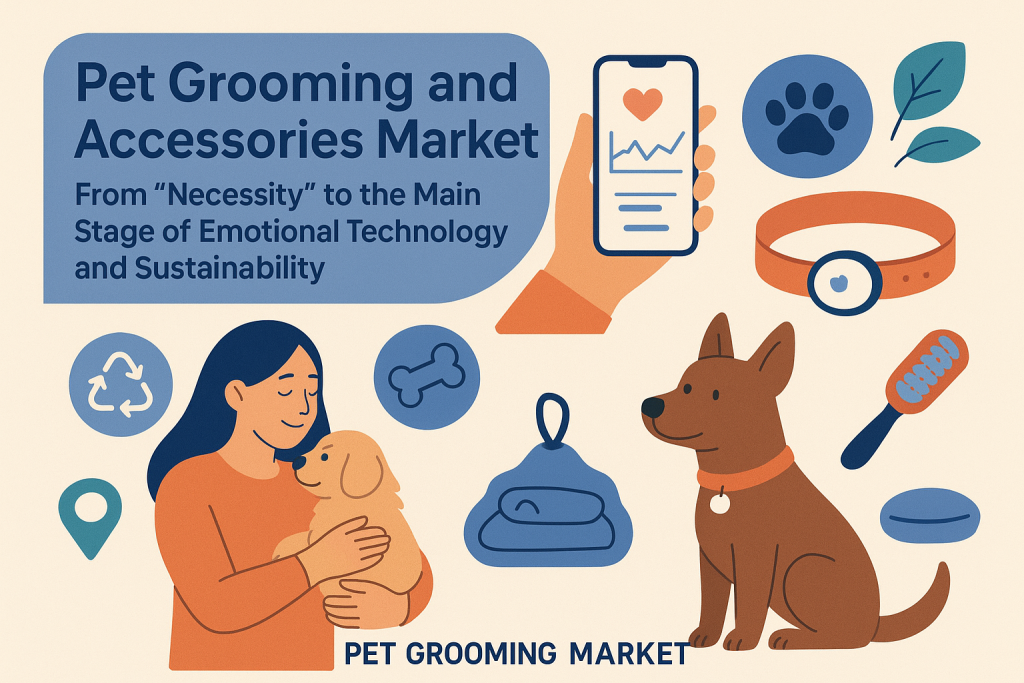1. Macromarket Size and Growth Forecast: The Key Milestone of 2026
The global pet grooming and accessories market was valued at approximately USD 77.12 billion in 2024 and is expected to reach around USD 135.20 billion by 2032, representing a compound annual growth rate (CAGR) of 7.37% during 2025–2032.
From this base, the market size for 2025 can be inferred at about USD 82.20 billion, and assuming a steady growth trajectory, the 2026 figure is estimated to range between USD 88 and 90 billion. The market is expected to continue growing at an annual rate of roughly 7% thereafter.
In comparison, the global market for grooming products alone (such as shampoos, conditioners, and brushes) was valued at about USD 13.88 billion in 2023 and is projected to reach approximately USD 21.05 billion by 2030, with a CAGR of around 6.2%.
Meanwhile, the global pet accessories market stood at about USD 21.9 billion in 2024, with estimates placing it at around USD 22.9 billion in 2025 and USD 43 billion by the mid-2030s, growing at a similar 7% annual rate.
Combining grooming and accessories, the overall market is likely to approach USD 90 billion in 2026, with annual growth remaining between 5% and 8% through 2032. However, subcategories such as care products, tools, fashion accessories, smart devices, and services are expected to expand at different rates.

2. Major Growth Drivers and Trends: Key Directions Beyond 2026
Pet Technology Integration
Wearables, smart collars, automatic feeders, and health monitors are reshaping the traditional pet accessories sector. These products reflect the convergence of hardware, data, and mobile applications—transforming basic accessories into parts of connected ecosystems.
The emergence of multifunctional smart collars, health tracking systems, and activity monitors illustrates how digitalization is redefining pet care. Exhibitions and expos worldwide have increasingly featured intelligent hardware, signaling an accelerated shift toward connectivity and data-driven functionality.
Sustainability and Humanization
Consumers are showing growing concern for eco-friendly materials, recyclability, and natural ingredients. Locally produced, biodegradable, or carbon-neutral pet goods are gaining appeal.
Designs that emphasize aesthetic harmony between pets and owners—such as matching outfits or coordinated accessories—reflect the cultural trend of pets being treated as family members and lifestyle companions.
Omni-channel Expansion
Although physical stores remain important for experiential shopping, online platforms, subscriptions, social commerce, and live-streaming sales continue to gain momentum. Hybrid models combining online convenience with in-person service—such as pop-up stores and integrated grooming boutiques—are expected to shape the retail landscape.
Service-based and Value-added Models
Grooming services are evolving beyond basic cleaning into spa, hydrotherapy, and dermatological care experiences, especially for premium breeds. Mobile grooming, home-visit services, and digital booking platforms are expanding coverage and convenience.
Regional Variations and Emerging Markets
North America remains the largest market, but Asia-Pacific—particularly China, India, Japan, and South Korea—is rapidly expanding due to urbanization and rising disposable incomes. Meanwhile, emerging markets in South America, the Middle East, and Africa, though smaller in scale, are showing increasing potential as pet culture spreads globally.
3. 2026 Market Outlook by Segment
| Segment | Estimated 2026 Market Size / Growth Trend | Core Opportunities | Challenges / Constraints |
|---|---|---|---|
| Shampoos & Care Products | ~USD 2–2.5 billion | Natural, hypoallergenic, and functional formulas; skin and coat health specialization | Ingredient sourcing, regulatory differences |
| Grooming Tools & Equipment | ~USD 1–1.5 billion | Smart, portable, app-enabled devices | Product safety, reliability, price competition |
| Pet Apparel & Fashion Accessories | ~USD 0.8–1.2 billion | Sustainable materials, lifestyle-oriented design, seasonal and themed collections | Inventory management, fit customization |
| Smart Devices & Wearables | ~USD 0.5–0.8 billion | Health tracking, location monitoring, behavioral insights | Battery life, data privacy, user adoption |
| Grooming & Care Services | ~USD 1.5–2 billion | Premium experiences, franchise and chain operations | Labor costs, service consistency, profit margin control |
Altogether, these segments support an estimated total market size close to USD 90 billion in 2026. The industry will enter a stage where technology, experience, and differentiation drive competition simultaneously.
4. Strategic Insights: How to Stand Out Beyond 2026
Focused Market Positioning
New entrants should avoid spreading resources across all subcategories. Instead, they can target specific pain points—such as skin health care, sustainable grooming tools, or intelligent monitoring devices—to establish early brand differentiation.
Build Data-driven Ecosystems
Hardware alone is not enough for lasting competitiveness. Integrating software, analytics, health reports, and membership programs can create a closed-loop system that strengthens user retention and data-based value.
Strengthen Trust and User Education
Pet owners are highly sensitive to health and safety concerns. Transparency in product labeling, certifications, and after-sales service—along with endorsements from veterinarians and credible communities—helps build long-term trust.
Combine Channels and Community Engagement
A balanced mix of online and offline touchpoints is essential. Experience stores, community grooming vans, and partnerships with pet cafés or veterinary clinics can enhance brand loyalty and customer reach.
Localized Global Strategies
Regional differences in pet culture, income levels, and climate require localization in both design and marketing. Collaborations or acquisitions of local brands can provide a faster and more effective market entry.
Sustainability as a Brand Identity
Eco-conscious production, reduced packaging, carbon-neutral operations, and animal welfare initiatives will increasingly serve as differentiators, especially for younger consumer segments seeking ethical consumption.
Conclusion: 2026 as a Turning Point
The year 2026 will mark a critical inflection point for the pet grooming and accessories industry. Growth will no longer rely solely on volume—it will depend on innovation, emotional connection, and sustainable development.
Brands that embrace technology, personalization, and service differentiation will emerge as leaders, while those trapped in low-cost, homogeneous competition may face gradual marginalization.
